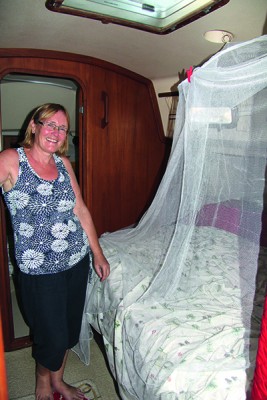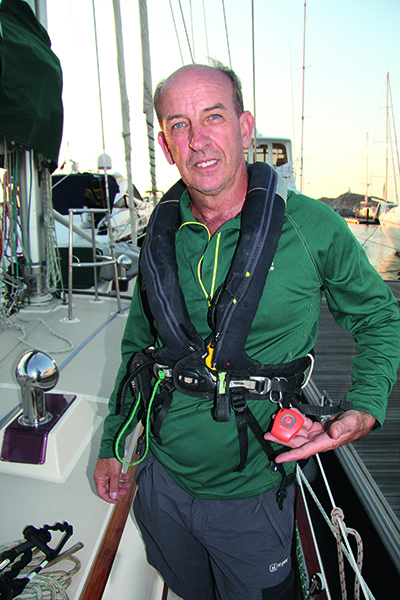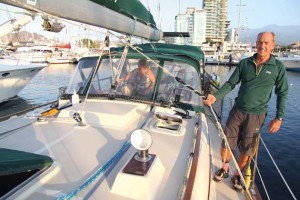At their first stopover in Colombia, World ARC crews talk to David Glenn about choosing boats, modifications and the sensitive issue of security for a circumnavigation
In most cases this leg, the first of almost 30, helped settle crews who were embarking on one of the biggest adventures of their lives.
It’s the World ARC’s second visit to this historic city of 455,000 people where authorities were keen to make the international yachtsmen, women and children from 17 nations feel welcome and safe, and to emphasise that one of South America’s oldest existing cities is a destination not just a stopover. Read Toby Hodges’s view of Santa Marta and the first World ARC stopover here
Nationwide efforts have been made to improve Colombia’s drug-tainted reputation and attracting a fleet like this is part of a campaign to clean up the country’s act.
Colombia’s Caribbean coast used to be a no-go area for yachtsmen, so big improvements have been made, but with poverty still widespread, the arrival of a group of well-heeled, high-visibility visitors trains a spotlight on potential security issues.

Taganga, Caribbean Coast, Colombia, South America
With barely a week in port the crews made the most of their stay, taking in organised cultural tours, barbecues on pristine beaches, visits to the nearby Tayrona National Park, dramatic helicopter flights along the spectacular coastline and time spent sampling the local cuisine in the attractive old town’s many restaurants.
The cost of living here is jaw-droppingly low – about one third of Europe’s prices – and the locals disarmingly welcoming and helpful. But World ARC has only been able to make its Santa Marta stops following the opening in 2010 of a 256-berth marina, an initiative supported by influential local businessman Manuel Abondano whose multi-national organic foods and palm oil company, Daabon, is involved in trying to improve the local infrastructure and attract outside investment. He sees the yachting community as a key player in his efforts.
Coinciding with the World ARC’s arrival were 23 yachts on an Ocean Cruising Club western Caribbean rally. The marina took it all in its stride and those who knew the area said Santa Marta was now very much ‘on the circuit’.
Security issues
I didn’t hear a single word from crews about security issues, but I have to report that they do still exist. I was the victim of an attempted mugging while returning to my hotel at about 1930 one evening. A group of youths confronted me and while one distracted me another attempted to take my backpack. Luckily it was zipped up, I managed to extract myself and make a run for it.
This happened just hours after I’d posted a story on Yachting World’s website about the area being reportedly safe despite an armed burglary aboard an Australian yacht anchored in a popular bay just to the north two months earlier.
Vice president of Colombia’s tourist department Sandra Howard, making a special visit to the World ARC stopover, accepted that incidents like the yacht burglary are sadly inevitable, but insisted that they are rare, the work of opportunists rather than organised crime.
The message is simple. Improvements have been made, but where poverty rubs shoulders with relative wealth there is potential for trouble.
The visiting yachtsmen I met took a pragmatic view. Common sense and simple precautions like not walking alone after dark and not spending too long alone in remote anchorages should be adopted. It’s advice World ARC will no doubt carry with it round the world.
All in all, the crews had a ball in Santa Marta soaking up its vibrant atmosphere, fascinating history and welcoming local population. They do, however, need to remain extra-vigilant.
Fit for purpose
Baltic 56 Spirit V
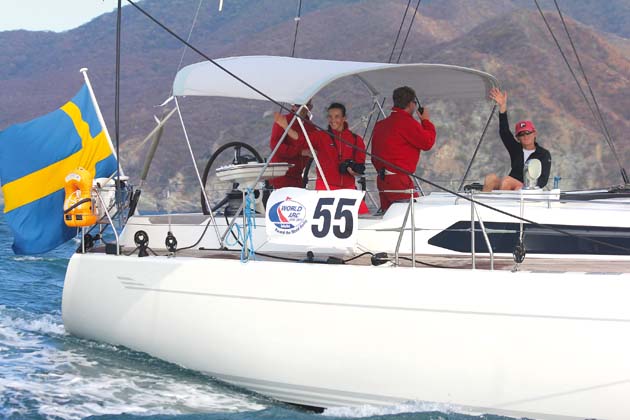
Erik Lindgren and Pia Hultgren
World ARC is not a race primarily, but the question of choosing a yacht capable of covering long distances quickly and comfortably under sail is one many wrestle with.
Leading the fleet by some distance into Santa Marta was the Swedish-flagged Baltic 56 Spirit V, owned by e-commerce entrepreneur Erik Lindgren and his partner Pia Hultgren, a professional meteorologist. They were sailing with friends, Eivind Boymo-Malm, a sailmaker, and Lena Having, both experienced racing sailors.
Spirit took about four days to complete the 815-mile downwind leg, declaring 12.73 hours of motoring. By comparison, the Oyster 56 Aliena took 24 hours longer, declaring just under ten hours of motoring. In 30 knots of breeze, close to the Colombian coast, Spirit sat on 15 knots for almost an hour under full main and symmetric spinnaker and it took all the crew’s skill to keep her there.

The result was that they enjoyed not only some sublime sailing, but also gained an extra day in Santa Marta over the rest of the fleet. It’s something Lindgren and Hultgren hope to repeat throughout the rally.
Lindgren said that when choosing a yacht, he concluded that most of the time they would be sailing downwind in 10-15 knots of true breeze. “We wanted a boat that sailed in 15 knots,” he said. “I really didn’t want to motor sail round the world.”
He revealed that Hallberg-Rassy, Gunfleet, Discovery and Oyster had all been on his possibles list, but adequate downwind performance was an issue when it came to ‘more traditional bluewater cruising yachts’, as he put it.
Designed by Judel/Vrolijk, Spirit is a carbon-fibre build displacing just under 20 tons in loaded World ARC mode. Compare that with an Oyster 56 displacing about 30 tons in similar trim. Spirit is fitted with a lifting keel, reducing draught to 2.3m, which is extremely useful in an event like this, although Baltic Yachts had to be despatched to the Caribbean recently to correct a faulty locking device.
When Spirit arrived in Santa Marta she looked as though she’d been out for a day sail. No transom festooned with equipment, no jerrycans lashed to the rail and the dinghy tucked away in the lazarette. Tankage for 800lt of diesel and 400lt of water plus a Spectra 400 watermaker provide all their needs. “I have two empty jerrycans for safety, but I have no intention of using them,” said Lindgren.
The couple were keen to have plenty of living space below so they chose a yacht with three double sleeping cabins, forgoing the fourth, which would normally be found in a yacht of this size. It meant the boat was more spacious below, lighter for her length and cheaper. The only change below was replacing the previous owner’s choice of décor – pink upholstery and stainless steel trim!
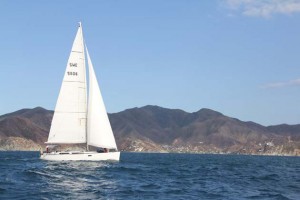
The most significant failures on the leg from Saint Lucia were the loss of a circlip on the spinnaker spigot at the mast, which was spotted during a daily inspection, saving worse damage, and the parting of the main halyard. The crew had actually trained for this eventuality and had the sail rehoisted in 15 minutes.
The cause of the failure was the breakdown of the Vectran core by U/V penetration of the outer cover, which showed no sign of wear itself. The halyard had, however, spent five years under the Mediterranean sun.
Spirit’s other weapon is Hultgren’s professional meteorological knowledge, which earlier in the ARC had helped them thread their way between two areas of light wind and thus record a class win. They averaged more than nine knots for their Atlantic crossing.
She told us that for the first half of the ARC she used Seaware software from Storm Geo with data from the Reading-based European Centre for Medium-Range Weather Forecasts (ECMWF) and then in the Caribbean used Expedition software using data from the American weather model Global Forecast System (GFS) via Mailasail.
Hultgren’s ability to analyse this information to put the yacht in the right place is clearly a useful tool aboard a yacht that thrives in light-medium downwind conditions.
Although it took Erik Lindgren ten years to prepare for the ARC and the World ARC, he had to turn back after encountering bad weather leaving the Mediterranean en route to the 2014 ARC start in the Canaries. “Preparation is absolutely everything,” he said. For large parts of this event Lindgren and Hultgren plan to sail double-handed.
Alarming advice
Island Packet 45 Time Bandit

Stuart and Anne Letton
Another yacht that has put serious miles under her keel of late is Stuart and Anne Letton’s Island Packet 45, Time Bandit. In the past two years alone she has sailed almost 11,000 miles, taking in ARC Plus (Canaries to the Caribbean via the Azores) in 2014 and last year cruised from Grenada to Maine and then back to Jamaica from where they had just arrived following a lively sail across the western Caribbean.
Although not part of World ARC she was joining ARC Panama, a newly formed service provided by the World Cruising Club to help yachts through the canal.
Letton was keen to show us some simple security devices aboard Time Bandit:
- A custom-built stainless steel grill which secures the companionway and can be locked from the inside, but in hot climates allows a free flow of air.

- A motion-activated sensor with a high-pitched 200dB alarm. For comparison, a 12-bore shotgun blast is about 170dBA. Stuart straps this to a vertical pole in the saloon before going to bed – £20 from B&Q.
- An alarm lock which, if knocked or fiddled with, emits a 110dB alarm for 35 seconds. Secure Sight Alarmalock, about US$20.
- He also carries a variety of padlocks, cables and 5m of chain for securing the dinghy, outboard motor, etc.
“We take these precautions when we are in places where the haves and the have-nots come together,” said Letton. What about carrying guns? “No. It’s a big step.”
Anne, prone to mosquito bites and a light sleeper, showed us the following:
- Simple mosquito net for their double berth bought in an IKEA in Las Palmas.

- Car windscreen sunshine and heat deflector cut up to fit portholes. This acts as a very effective blackout and also heat insulator in intense sunshine.
Back on deck Stuart Letton showed us the following:
- Instead of running harness jacklines along the side deck Letton sets them well inboard along the top of the coachroof. This means that, when clipped on with a medium-length tether, if you fall there is little chance of going over the lifelines.
- In addition to carrying a personal EPIRB when on watch, Stuart and Anne Letton wear a Raymarine Lifetag which, when activated in an MOB situation, immediately sets off an alarm on the yacht

Stuart shows off his Raymarine Lifetag MOB alarm
- Continual movement and occasional shock loadings on the solid vang eventually led to the lower fitting being pulled out of the mast. To reduce this load, Letton sets up a separate soft vang from a strop near the mainsheet attachment point on the boom to the leeward toerail. The strop spreads the load.

The line he uses for the vang is a climbing rope with a lot of stretch and he also fits a rubber snubber to ease the shock loading. When tensioned this reduces the damaging loads on the vang. Letton is considering replacing the solid vang with a rope tackle and fitting a topping lift.
- He praised Strataglass, a coated, flexible clear vinyl for use in sprayhood windows. “It stays clearer,” he claimed.






